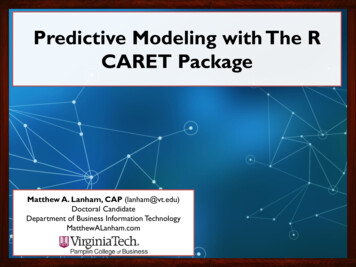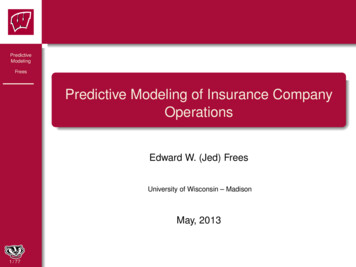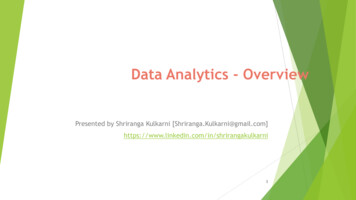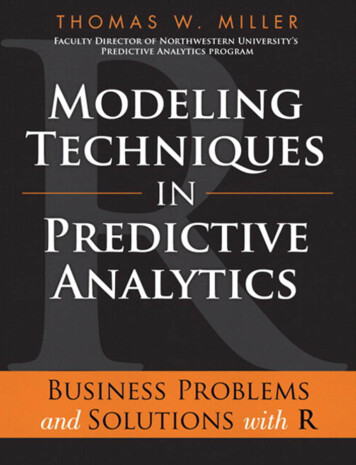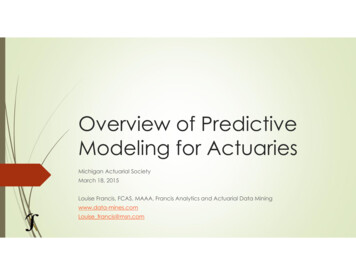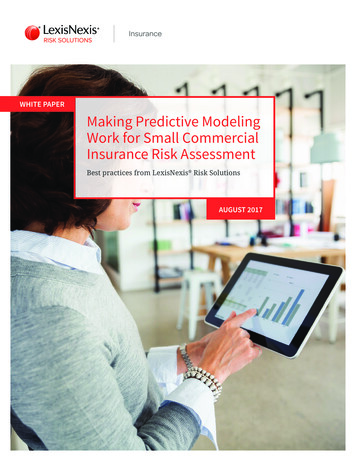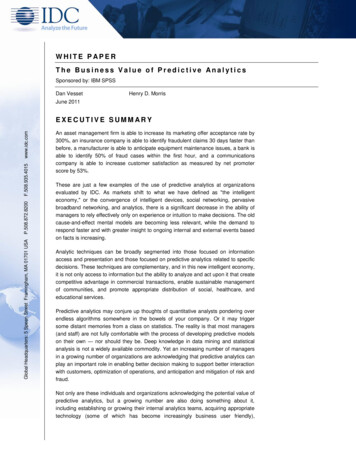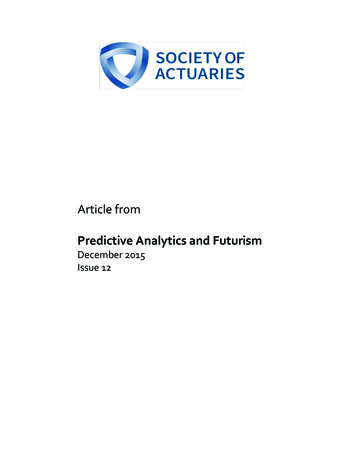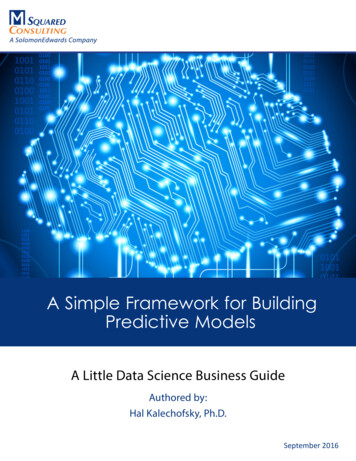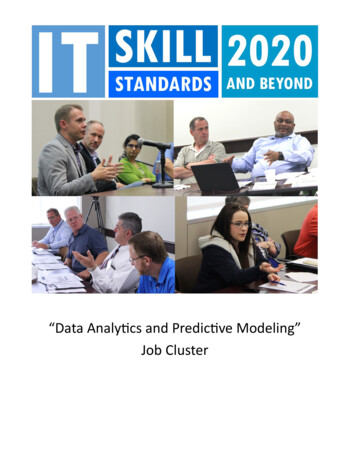
Transcription
“Data Analytics and Predictive Modeling”Job Cluster
AcknowledgementsThe development and publication of these skill standards has been a joint and collaborative effortbetween business and industry representatives and the education community. We are grateful to theindustry personnel who participated in the development and validation process. Industry subject matterexperts, technical executives, supervisors and technicians donated their time and effort to assure therelevancy of the standards 12 to 36 months into the future.We gratefully acknowledge funding from the National Science Foundation and the leadership bythe team on the IT Skill Standards 2020 and Beyond grant, based at Collin College.Our leaders are strategically divided into Central, Western, and Eastern teams.CentralDr. Ann Beheler, Principal InvestigatorChristina Titus, Program DirectorDeborah Roberts, Co-Principal InvestigatorHelen Sullivan, Senior StaffWest CoastTerryll Bailey, Co-Principal InvestigatorDr. Suzanne Ames, Co-Principal InvestigatorEast CoastPeter Maritato, Co-Principal InvestigatorGordon Snyder, Senior StaffThis material is based upon work supported by the National Science Foundation under Grant No. 1838535. Anyopinions, findings and conclusions or recommendations expressed in this material are those of the author(s) anddo not necessarily reflect the views of the National Science Foundation.
itskillstandards.orgData Analytics and Predictive ModelingThe definition for Data Analytics and Predictive Modeling as developed by approximately 100 ThoughtLeaders (mostly Chief Technology Officers and Chief Information Officers) through three meetings andfollow-up surveys to gain consensus is:Data Analytics and Predictive Modeling includes inspecting, cleansing, transforming, and modelingdata with the goal of discovering useful information, informing conclusions, and supportingdecision-making. Business intelligence (BI) specifically focuses on extracting business informationfor use by decision makers. Common functions of business intelligence include reporting, datamining, process mining, benchmarking, and text mining. This definition was adapted fromWikipedia with input from IT Thought Leaders.This packet includes Job skills as developed by subject matter experts (SMEs) via multiple synchronous meetings (Page 3).The tasks, knowledge, skills and abilities (KSAs) were developed with a focus 12 to 36 months in thefuture for an entry-level employee working in that specific cluster.More specific definitions can be found within the KSA list.The average was calculated from the subject matter expert votes. A vote of "4" indicated the item must be covered in the curriculum.A vote of "3" indicated the item should be covered in the curriculum.A vote of "2" indicated that it would be nice for the item to be covered in the curriculum.A vote of "1" indicated the item should not be covered in the curriculum.Employability Skills as developed by SMEs via multiple synchronous meetings (Page 7).Employability competencies are essential for every IT job and are based on what the work requires.SMEs were offered three clearly-defined “levels of proficiency” for each employability skill. Theproficiency scale is defined as Level 1 – basic; Level 2- intermediate; and Level 3 - advanced. The levelsare cumulative, so a “Level 3” assumes the employee can perform all characteristics of “Level 1” and“Level 2.”For each employability skill, SMEs selected the competency levels that best aligned with what would beexpected from an entry-level worker for the job cluster in question.Key Performance Indicators (KPIs) as developed by SMEs (Page 8).Key Performance Indicators answer the question, “How do we know when a task is performed well?”A search was performed to locate validated/verified KPIs for technician level work in IT fields. Sourcesincluded the Texas Skill Standards System, National Skill Standards Board, National Institute of Standardsand Technology and other sources. The identified KPIs were then cross-referenced to the tasks for the1
ITSS 2020 job clusters. They were reviewed and revised by a group of the same subject matter expertswho developed the tasks and KSAs for the cluster in a structured, facilitated verification session.Student Learning Outcomes (SLOs) as identified by educators attending the KSA meetings (Page 10).The SLOs are for use in the creation of curriculum to help define what the students will know and beable to demonstrate. Each of these SLOs can be observed, measured, and demonstrated.2
Data Analytics and Predictive Modeling Tasks and KSAsTaskSPECIFIC THINGS an entry level person would BE EXPECTED TO PERFORM on the job WITH LITTLE SUPERVISION.Business Problem (Question) FramingAssist in obtaining or receiving problem statement and usability requirements.T-1Assist in identifying stakeholders.T-2Assist in determining if the problem is amenable to an analytics solution.T-3Assist in refining the problem statement and delineate.T-4Assist in defining an initial set of business benefits.T-5Assist in obtaining stakeholder agreement on the problem.T-6Analytics Problem FramingAssist in reformulating the problem statement as an analytics problem.T-7Assist in developing a proposed set of drivers and relationships to outputs.T-8Assist in stating the set of assumptions related to the problem.T-9T-10 Assist in defining key metrics of success.T-11 Assist with collecting metrics and trending data.T-12 Assist in obtaining stakeholder agreement on analytical approach.DataT-13 Assist with identifying and prioritizing data needs and sources.T-14 Assist with assessing the validity of source data and subsequent findings.T-15 Assist in acquiring data.T-16 Assist in harmonizing, rescaling, cleaning, and sharing data.T-17 Assist with identifying relationships in the data.T-18 Assist with documenting and reporting findings (e.g., insights, results, business performance).T-19 Assist with refining the business and analytics problem statements.Methodology (Approach) SelectionT-20 Assist with identifying available problem solving approaches (methods).T-21 Assist in conferring with systems analysts, engineers, programmers, and others to design application.T-22 Assist in using software tools.Assist in reading, interpreting, writing, modifying, and executing simple scripts (e.g., Perl, VBScript) onWindows and UNIX systems (e.g., those that perform tasks such as: parsing large data files, automatingT-23 manual tasks, and fetching/processing remote data).Assist in utilizing different programming languages to write code, open files, read files, and write output toT-24 different files.Assist in utilizing open source language such as R and apply quantitative techniques (e.g., descriptive andinferential statistics, sampling, experimental design, parametric and non-parametric tests of difference,T-25 ordinary least squares regression, general line).T-26 Assist with developing and implementing data mining and data programs.T-27 Assist with testing approaches (methods).T-28 Assist in conducting hypothesis testing using statistical processes.T-29 Assist with providing analyses and support for effectiveness assessment.T-30 Assist with selecting approaches (methods).Model BuildingT-31 Assist with identifying model structures.T-32 Assist in running and evaluating the models.T-33 Assist with tuning models and data.T-34 Assist with integrating the models.T-35 Assist with documenting and communicating findings (including assumptions, limitations and constraints).T-36 Assist with performing internal business verification and validation of the model.T-37 Assist with publishing validation and verification report.T-38 Assist in developing recommendations to the supervisor based on data analysis and 73.43.12.83.33.13.43.22.93.73.02.93.1
51T-52Assist with deploying application codes and analytical models using CI/CD tools and techniques andprovides support for deployed data applications and analytical models.Assist with performing business validation of the model.Assist with presenting technical information to technical and nontechnical audiences.Assist with presenting data in creative formats.Assist with delivering reports with findings.Assist with creating model, usability, and system requirements for production.Assist in supporting deployment.Model Lifecycle ManagementAssist with documenting initial structure.Assist in tracking model quality.Assist with providing input and assist in post-action effectiveness assessments.Assist in the identification of information collection shortfalls.Assist with recalibrating and maintaining the model.Assist with evaluating the business benefit of the model over time.Assist with developing strategic insights from large data wledgeKnowledge focuses on the understanding of concepts. It is theoretical. An individual may have an understanding of a topic or toolor some textbook knowledge of it but have no experience applying it. For example, someone might have read hundreds of articleson health and nutrition, many of them in scientific journals, but that doesn't make that person qualified to dispense advice -25K-26Knowledge of risk management processes (e.g., methods for assessing and mitigating risk).Knowledge of computer algorithms.Knowledge of computer programming principles.Knowledge of data administration and data standardization policies.Knowledge of data mining and data management principles.Knowledge of database management systems, query languages, table relationships, and views.Knowledge of mathematics (e.g., logarithms, trigonometry, linear algebra, calculus, statistics, andoperational analysis).Knowledge of programming language structures and logic.Knowledge of query languages such as SQL (structured query language).Knowledge of sources, characteristics, and uses of the organization’s data assets.Knowledge of the various technologies for organizing and managing information (e.g., databases,bookmarking engines).Knowledge of command-line tools (e.g., mkdir, mv, ls, passwd, grep).Knowledge of interpreted and compiled computer languages.Knowledge of how to utilize Hadoop, Java, Python, SQL, Hive, and Pig to explore data.Knowledge of machine learning theory and principles.Knowledge of data classification standards and methodologies based on sensitivity and other risk factors.Knowledge of Personally Identifiable Information (PII) data security standards.Knowledge of the principal methods, procedures, and techniques of gathering information and producing,reporting, and sharing information.Knowledge of data mining techniques.Knowledge of database theory.Knowledge of how to extract, analyze, and use metadata.Knowledge of ETL techniques, Hadoop, Data analytics, Big data is an advantage.Knowledge of a variety of machine learning techniques (clustering, decision tree learning, artificial neuralnetworks, etc.) and their real-world advantages/drawbacks.Knowledge of advanced statistical techniques and concepts (regression, properties of distributions,statistical tests and proper usage, etc.) and experience with applications.Knowledge of the underlying theory and concepts of Relational Databases (e.g., Microsoft SQL Server,Oracle, Teradata MySQL).Knowledge of Decision Science Game 3.32.72.93.13.42.83.02.93.23.22.82.9
Knowledge of the use of simulation.3.1Knowledge of optimization.3.3Knowledge of data analysis concepts.3.6Knowledge of how to identify and document potential ethical concerns for application of model outputs.3.1SkillsThe capabilities or proficiencies developed through training or hands-on experience. Skills are the practical application oftheoretical knowledge. Someone can take a course to gain knowledge of concepts without developing the skills to apply thoseconcepts. Development of skills requires hands-on application of the concepts.Skill in conducting queries and developing algorithms to analyze data structures.S-13.5Skill in creating and utilizing mathematical or statistical models.S-23.3Skill in data mining techniques (e.g., searching file systems) and analysis.S-33.3Skill in using and contributing content to data dictionaries.S-42.7Skill in developing data models.S-53.0Skill in generating queries and reports.S-63.5Skill in writing code in a currently supported programming language (e.g., Python).S-72.9Skill in data pre-processing (e.g., imputation, dimensionality reduction, normalization, transformation,extraction, filtering, smoothing).S-83.0Skill in identifying patterns or relationships.S-93.1S-10 Skill in performing sentiment analysis.3.3Skill in Regression Analysis (e.g., Hierarchical Stepwise, Generalized Linear Model, Ordinary Least Squares,S-11 Tree-Based Methods, Logistic).3.1S-12 Skill in supporting transformation analytics to invoke a business shift.2.9S-13 Skill in using basic descriptive statistics and techniques (e.g., normality, model distribution, scatter plots).3.4S-14 Skill in using data analysis tools (e.g., Excel, Python).3.3S-15 Skill in using data mapping tools.2.9S-16 Skill in using outlier identification and removal techniques.3.33.5S-17 Skill in writing scripts using R, Python, PIG, HIVE, SQL, etc.S-18 Skill to identify sources, characteristics, and uses of the organization’s data 93.0Skill in developing or recommending analytic approaches or solutions to problems and situations for whichS-20 information is incomplete or for which no precedent ty,validity,andrelevance.S-212.93.1S-22 Skill in preparing and presenting briefings.S-23 Skill in tailoring analysis to the necessary levels (e.g., classification and organizational).2.9Skill in using multiple search engines (e.g., Google, Yahoo, LexisNexis, DataStar) and tools in conductingS-24 open-source searches.2.8S-25 Skill in utilizing feedback to improve processes, products, and services.3.1S-26 Skill in performing data analysis including applying statistics.3.6Skill in using statistical computer languages (R, Python, etc.) to manipulate data and draw insights fromS-27 large data sets.3.5S-28 Skill in Visualization using R, Python, or other languages and frameworks.3.4S-29 Skill in problem-solving skills and critical thinking ability.3.6S-30 Skill in collaboration and communication skills within and across teams.3.6S-31 Skill in analytics problem framing (e.g., define geometric sets).3.5K-27K-28K-29K-30AbilitiesAbilities have historically been used to describe the innate traits or talents that a person brings to a task or situation. Many peoplecan learn to negotiate competently by acquiring knowledge about it and practicing the skills it requires. A few are brilliantnegotiators because they have the innate ability to persuade. In reality, abilities may be included under skills or may be separatedout.A-1A-2A-3Ability to dissect a problem and examine the interrelationships between data that may appear unrelated.Ability to identify basic common coding flaws at a high level.Ability to use data visualization tools (e.g., Flare, HighCharts, AmCharts, D3.js, Processing, GoogleVisualization API, Tableau, Raphael.js).53.23.03.3
A-8A-9A-10A-11A-12A-13Ability to source data used in information, assessment, and/or planning products.Ability to communicate complex information, concepts, or ideas in a confident and well-organized mannerthrough verbal, written, and/or visual means.Ability to develop or recommend analytic approaches or solutions to problems and situations for whichinformation is incomplete or for which no precedent exists.Ability to evaluate, analyze, and synthesize large quantities of data (which may be fragmented andcontradictory) into quality, fused targeting/information products.Ability to clearly articulate information requirements into well-formulated research questions and datatracking variables for inquiry tracking purposes.Ability to effectively collaborate via virtual teams.Ability to evaluate information for reliability, validity, and relevance.Ability to exercise strong ethical judgment when policies are not well-defined.Ability to focus research efforts to meet the customer’s decision-making needs.Ability to adapt to a dynamic 23A-24Ability to function in a collaborative environment, seeking continuous consultation with other analysts andexperts—both internal and external to the organization—to leverage analytical and technical expertise.Ability to identify information gaps.Ability to recognize and mitigate cognitive biases which may affect analysis.Ability to recognize and mitigate deception in reporting and analysis.Ability to think critically.Ability to understand objectives and effects.Ability to utilize multiple information sources across all information disciplines.Ability to effectively communicate ideas to team members with varying levels of technical expertise.Ability to understand a business problem.Ability to understand and use the databases and tools to run queries to solve the business problem.Ability to identify .23.63.13.12.93.83.33.23.73.73.73.3
Data Analytics and Predictive Modeling Employability SkillsWorkplaceProfessionalismand Work EthicsLevel 1 - Employee learns expectations of workplace environment (professional behavior and ethics)and adheres to practices with some guidance.Level 2 - Employee exhibits sound professionalism, judgment, and integrity and accepts responsibilityfor own behavior. Employee exhibits these qualities without guidance but occasionally refers topolicies as needed.WrittenCommunicationLevel 1 - Employee understands written instructions and executes tasks with guidance and feedbackfrom supervisor. Employee clearly communicates concepts in writing.Level 2 - Employee comprehends and executes written instructions with minimal guidance. Employeecomposes well-organized written documents.OralCommunicationLevel 1 - Employee understands oral instructions and executes tasks with guidance and feedback fromsupervisor. Employee communicates concepts orally while clarifying for meaning. Employee developslistening skills.Level 2 - Employee comprehends and executes oral instructions with minimal guidance and exhibitsgood listening skills. Employee clarifies for meaning without needing prompting from supervisor.TeamworkLevel 1 - With guidance and feedback from supervisor, employee obeys team rules and understandsteam member roles. Employee actively participates in team activities, volunteers for special tasks, andestablishes rapport with co-workers.Problem Solving & Level 1 - Employee identifies the problem and relevant facts and principles with guidance and feedbackfrom supervisor. Employee summarizes existing ideas and demonstrates creative thinking process whileCritical Thinking problem solving.Organization andPlanningLevel 1 - Employee prepares schedule for self, monitors and adjusts task sequence, and analyzes workassignments with guidance from supervisor.Level 2 - Employee manages timelines and recommends timeline adjustments. Employee escalatestimeline-impacting issues as appropriate.Adaptability andFlexibilityLevel 1 - With guidance and feedback from supervisor, employee is able to adjust ways of doing workbased on changing dynamics. Working under pressure is difficult, but employee makes it through theproject with guidance and oversight.InitiativeLevel 1 - Employee finishes a step in a project and waits for direction before going on to the next step.Level 2 - Employee finishes multiple steps in a project and appropriately begins working on the nextstep without being asked.AccuracyLevel 1 - Employee makes mistakes routinely but is committed to learning to adjust work habits toprevent them in the future.Level 2 - Employee occasionally makes mistakes but quickly makes adjustments to work habits to avoidmaking the same mistake twice.CulturalCompetenceLevel 1 - Employee is inexperienced with working with diverse teams. With support and guidance andgetting to know team members, employee develops working relationships.Level 2 - Employee is committed to working with diverse teams but struggles when differences arise.Employee identifies those challenges and works with colleagues to find ways to work effectively.Self and CareerDevelopmentLevel 1 - Employee requires feedback and direction from supervisor regarding improvement needed inprofessional and technical skills. Employee follows through with skills development with monitoring bysupervisor.7
Data Analytics and Predictive Modeling Key Performance IndicatorsFor the entry-level employee, all tasks are typically done under supervision for much of the first year and then with some independence with verification after theemployee has more experience. All tasks are done according to company guidelines.TaskKey Performance IndicatorsBusiness Problem (Question) FramingT-1 Assist in obtaining or receiving problem statement and usability requirements. Appropriate stakeholders are identified in a timely manner.Problem statement and usability requirements are obtained in a timely mannerT-2 Assist in identifying stakeholders.and properly documented.T-3 Assist in determining if the problem is amenable to an analytics solution.Determination of the applicability of an analytics solution is accurate.T-4 Assist in refining the problem statement and delineate.Business and analytics problem statements are clear, and are benefits.T-5refined.Business benefits are correctly identified and clearly stated.T-6 Assist in obtaining stakeholder agreement on the problem.Analytics Problem FramingThe alternatives to the analytics problem statement are documented andranked according to best match with current problem and rationale for choicesclearly stated.Assumptions related to the problem are stated clearly and concisely.Criteria for success are clearly identified.Agreement of stakeholders is obtained regarding business and analytics problemstatements and analytic approach.T-7 Assist in reformulating the problem statement as an analytics problem.T-8 Assist in developing a proposed set of drivers and relationships to outputs.T-9 Assist in stating the set of assumptions related to the problem.T-10 Assist in defining key metrics of success.T-11 Assist with collecting metrics and trending data.T-12 Assist in obtaining stakeholder agreement on analytical approach.DataT-13 Assist with identifying and prioritizing data needs and sources.Sources and methods for acquiring data are efficient and information is accurateand complete.Data is secured from reliable and respected sources.Data is correctly harmonized, rescaled, and cleaned and relationships in the dataare correctly identified.Findings are documented in accordance with company procedures andcommunicated in a clear and timely manner.Data definitions are fully developed and agreed upon in accordance withcompany procedures.T-14 Assist with assessing the validity of source data and subsequent findings.T-15 Assist in acquiring data.T-16 Assist in harmonizing, rescaling, cleaning and sharing data.T-17 Assist with identifying relationships in the data.Assist with documenting and reporting findings (e.g., insights, results, businessT-18 performance).T-19 Assist with refining the business and analytics problem statements.Methodology (Approach) SelectionT-20 Assist with identifying available problem solving approaches (methods).Assist in conferring with systems analysts, engineers, programmers, and othersT-21 to design application.Sources and methods for acquiring data are efficient and information is accurateT-22 Assist in using software tools.and complete.Assist in reading, interpreting, writing, modifying, and executing simple scripts The alternatives to the methodology are documented and ranked.(e.g., Perl, VBScript) on Windows and UNIX systems (e.g., those that performData is secured from reliable and respected sources.tasks such as: parsing large data files, automating manual tasks, andFindings are documented in accordance with company procedures andT-23 fetching/processing remote data).communicated in a clear and timely manner.Assist in utilizing different programming languages to write code, open files,Data definitions are fully developed and agreed upon in accordance withT-24 read files, and write output to different files.company procedures.Assist in utilizing open source language such as R and apply quantitativeProblem solving approaches and methods are affordable and relevant.techniques (e.g., descriptive and inferential statistics, sampling, experimentalAnalysis processes and conclusions are clearly and concisely documented.design, parametric and non-parametric tests of difference, ordinary leastEffective software tools and problem-solving methods are used.T-25 squares regression, general line).Scripts are complete, relevant and congruent.Appropriate testing methodology is identified and planned and scope of testing isT-26 Assist with developing and implementing data mining and data programs.clearly identified.T-27 Assist with testing approaches (methods).Algorithms, programming principles, statistical processes are used correctly.T-28 Assist in conducting hypothesis testing using statistical processes.T-29 Assist with providing analyses and support for effectiveness assessment.T-30 Assist with selecting approaches (methods).Model BuildingT-31 Assist with identifying model structures.T-32 Assist in running and evaluating the models.Models are evaluated, tuned and integrated using the proper procedures.T-33 Assist with tuning models and data.Data model is laid out clearly.T-34 Assist with integrating the models.Performance criteria for the data model have verifiable assumptions.Scope and purpose of model are defined.Assist with documenting and communicating findings (including assumptions,Code is developed using efficient software design processes.T-35 limitations and constraints).Reusable components are employed whenever possible.T-36 Assist with performing internal business verification and validation of the model. Code is well documented so that it can be understood by others.Tests accurately assess the functions the module is designed to perform.T-37 Assist with publishing validation and verification report.Assist in developing recommendations to the supervisor based on data analysis Ethics reviews are routinely accomplished.T-38 and findings.8
T-39T-40T-41T-42T-43T-44T-45DeploymentAssist with deploying application codes and analytical models using CI/CD tools Application codes and analytical models are deployed according to plan.and techniques and provides support for deployed data applications andBusiness validation of the model is performed correctly.analytical models.Presentations are well-organized, utilize creative formats and meet the needs ofAssist with performing business validation of the model.technical and non-technical audiences.Enterprise goals are taken into account when drawing conclusions from dataAssist with presenting technical information to technical and nontechnicalanalysis and making recommendations to supervisor.audiences.Model, usability and system requirements for production are developed inAssist with presenting data in creative formats.accordance with company procedures.Assist with delivering reports with findings.Assist with creating model, usability, and system requirements for production. Requirements are properly interpreted and evaluated, and conflictingrequirements are identified and resolved.Assist in supporting deployment.Model Lifecycle ManagementT-46 Assist with documenting initial structure.Initial structure of the model is documented in accordance with companystandards and in a timely manner.Tracking of model quality and model recalibration and maintenance.Effectiveness testing is based on specification criteria.Recommendations are fed back into the modeling process.Computer data administration, data standardization, data mining and datamanagement are conducted in accordance with industry and companyprocedures and standards.T-47 Assist in tracking model quality.T-48 Assist with providing input and assist in post-action effectiveness assessments.T-49 Assist in the identification of information collection shortfalls.T-50 Assist with recalibrating and maintaining the model.T-51 Assist with evaluating the business benefit of the model over time.T-52 Assist with developing strategic insights from large data sets.9
Data Analytics and Predictive Modeling Student Learning 10KnowledgeKnowledge of risk management processes (e.g., methods for assessing andmitigating risk).Knowledge of data classification standards and methodologies based onsensitivity and other risk factors.Knowledge of Personally Identifiable Information (PII) data security standards.Knowledge of how to identify and document potential ethical concerns forapplication of model outputs.Knowledge of data administration and data standardization policies.Knowledge of the various technologies for organizing and managinginformation (e.g., databases, bookmarking engines).Knowledge of the principal methods, procedures, and techniques of gatheringinformation and producing, reporting, and sharing information.Knowledge of data mining and data management principles.Knowledge of data mining techniques.Knowledge of Decision Science Game theory.Knowledge of optimization.Knowledge of data analysis concepts.St
The definition for Data Analytics and Predictive Modeling as developed by approximately 100 Thought Leaders (mostly C hief Technology Officers and Chief Information Officers) through three meetings and follow-up surveys to gain consensus is: Data Analytics and Predictive Modeling includes inspectin
